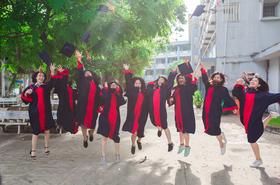- Since 1978, Cuyamaca College has provided a solid education to students, whether they�re beginning their university degree at Cuyamaca, returning to school to launch a career or to acquire new skills or enrolling in an innovative occupational program. With its vision of �Learning for the Future,� Cuyamaca College offers a wide scope of challenging courses, from drafting technology and child development to paralegal training, from computer and information science or ornamental horticulture to automotive technology. With 49 degree programs and 46 certificates offered at Cuyamaca College, learning opportunities abound under the tutelage of highly-qualified, dynamic instructors imbued with a love of teaching.
School Highlights
Cuyamaca College serves 12,859 students (29% of students are full-time).
The college's student-teacher ratio of 33:1 is higher than the state community college average of 32:1.
Minority enrollment is 54% of the student body (majority Hispanic), which is less than the state average of 77%.
Quick Facts (2025-26)
- Enrollment: 12,859 students
- In-state tuition: $1,386
- Out-state tuition: $6,896
- Student-teacher ratio: 33:1
- Minority enrollment: 54%
- Source: Integrated Postsecondary Education Data System (IPEDS)
School Overview
The teacher population of 384 teachers has stayed relatively flat over five years.
Cuyamaca College
(CA) Community College Avg.
Carnegie Classification
Associate's Colleges: High Transfer-Mixed Traditional/Nontraditional
Baccalaureate/Associate's Colleges: Associate's Dominant
Institution Level
At least 2 but less than 4 years
At least 2 but less than 4 years
Institution Control
Public
Public
Total Faculty
384 staff
315 staff
School Calendar
Student Body
The student population of Cuyamaca College has grown by 47% over five years.
The student-teacher ratio of 33:1 has increased from 23:1 over five years.
The Cuyamaca College diversity score of 0.66 is less than the state average of 0.70. The school's diversity has stayed relatively flat over five years.
Total Enrollment
12,859 students
9,796 students
Student-Teacher Ratio
33:1
32:1
# Full-Time Students
3,748 students
1,259 students
# Part-Time Students
9,111 students
8,537 students
# Enrollment Undergraduate
128 students
242 students
# Full-Time Undergraduate Students
3,748 students
1,250 students
# Full-Time Graduate Students
n/a
63 students
# Part-Time Undergraduate Students
9,111 students
8,299 students
# Part-Time Graduate Students
n/a
10 students
Total Dormitory Capacity
n/a
121 students
% American Indian/Alaskan
1%
n/a
% Asian
5%
13%
% Hispanic
34%
47%
% Black
5%
7%
% White
46%
23%
% Hawaiian
n/a
1%
% Two or more races
4%
5%
% Non Resident races
n/a
1%
% Unknown races
5%
3%
Diversity Score
0.66
0.70
College Completion Rate (Students who graduate in less than 4 years)
32%
42%
College Completion Rate (Students who graduate in 4 years or more than 4 years)
n/a
43%
Average Graduate Earnings (10 Years)
$32,600
$34,700
Tuition and Acceptance Rate
The public in-state tuition of $1,386 is less than the state average of $1,516. The in-state tuition has stayed relatively flat over four years.
The public out-state tuition of $6,896 is more than the state average of $6,779. The out-state tuition has declined by 27% over four years.
In-State Tuition Fees
$1,386
$1,516
Out-State Tuition Fees
$6,896
$6,779
Tuition Notes
$46/unit
% Students Receiving Some Financial Aid
78%
85%
Median Debt for Graduates (Year 2008)
$3,448
$6,625
Median Debt for Dropouts
$5,615
$6,239
Acceptance Rate
n/a
93%
Source: 2024 (or latest year available) Integrated Postsecondary Education Data System (IPEDS) , School Administrators
School Notes
- Cuyamaca College is located in the community of Rancho San Diego at 900 Ranch San Diego Parkway in the City of El Cajon on a 165-acre site which was at one time a part of the Old Monte Vista Ranch. Cuyamaca College is one of two colleges serving the Grossmont-Cuyamaca Community College District. The building site was acquired by the Board of Trustees in September 1972, and the College officially opened in the Fall of 1978. The second phase of buildings was completed in January 1980. In 1989, the Learning Resource Center opened. The campus consists of eight classroom buildings and is also the site of the Heritage of the Americas Museum and the Water Conservation Garden. In the Spring of 1995, Rancho San Diego Parkway, the Fury Lane entrance road, was completed providing students easier access to the College. In the Fall of 1995, the College dedicated a new 20.3 acre physical education facility with a fitness center, gym, tennis and volleyball courts, soccer and ball fields and an olympic track. Construction implementation is occurring on an incremental basis in response to the growing community surrounding the College and to meet the educational needs in the Grossmont-Cuyamaca Community College District. The College is designed to provide a comprehensive curriculum of programs and course of study, and when completed, will accommodate an enrollment of approximately 15,000 students in 2015. The mission of Cuyamaca College's Financial Aid Office is to ensure access and eliminate financial barriers to post-secondary education for all eligible students, by providing student centered support services that will promote student success, persistence, retention, equal educational opportunities and enable them to fully develop their individual potential.
Frequently Asked Questions
How much does Cuyamaca College cost?
Cuyamaca College's tuition is approximately $1,386 for In-State students and $6,896 for Out-State students.
What schools are Cuyamaca College often compared to?
Cuyamaca Collegeis often viewed alongside schools like Grossmont College by visitors of our site.
Recent Articles

How to Transfer from Community College to a Four-Year University in 2025
A step-by-step guide for community college students transferring to a four-year university in 2025 — updated strategies, data and expert insights.

Scholarships for Community College Students 2025
Explore updated scholarship programs, tuition data, and expert strategies for community college students in 2025.

The Rise of Technical and Vocational Training in 2025
Explore the 2025 surge in technical and vocational training—enrollment, policy, costs, and why this path is gaining ground for students and parents.









